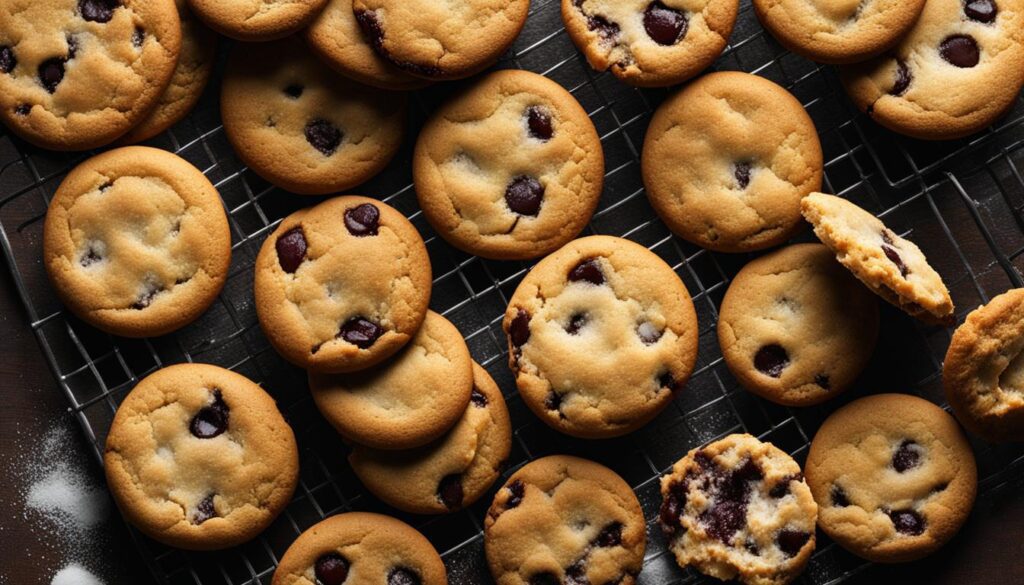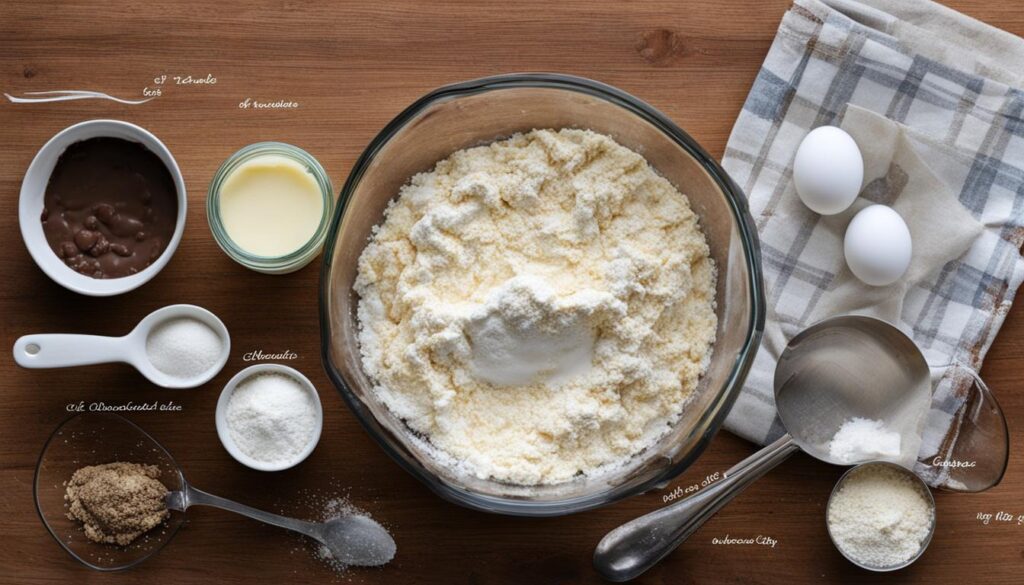Did you ever start baking a batch of delicious homemade cookies, only to realize halfway through that you forgot to add baking soda to the dough? Don’t worry, it happens to the best of us. Forgetting baking soda in your cookies can lead to changes in texture and taste, but there are easy fixes and alternative ingredients you can use to rescue your cookies.
So, what should you do if you forgot baking soda in your cookies? Don’t panic! In this article, we will guide you through some simple steps and offer valuable tips on how to salvage your cookies and still enjoy a treat that your taste buds will love.
If you’re wondering about a substitute for baking soda in cookies, we’ve got you covered. There are a few ingredients you can use as alternatives to baking soda that can still provide the desired leavening effect for your cookies. Whether you have baking powder, cream of tartar, whipped egg whites, or want to adjust your baking technique, we’ll help you find the best solution to ensure your cookies turn out just right.
Now, let’s dive into the reasons why baking soda is essential in cookies, explore the substitutes you can use, and even share a recipe for delicious chocolate chip cookies without baking soda. So, keep reading to become a baking expert and never let a forgotten ingredient ruin your cookie-baking experience again!
Why Baking Soda is Important in Cookies
Baking soda, also known as sodium bicarbonate, plays a crucial role in cookie baking. It interacts with acidic ingredients in the recipe, such as buttermilk, lemon juice, or brown sugar, to create a chemical reaction that helps the dough rise and results in a light and fluffy texture. Baking soda also contributes to the development and enhancement of flavors during baking. Its absence can lead to denser, flatter cookies with less complex flavors.

“Baking soda acts as a leavening agent in cookies, creating air pockets and helping them rise during baking. It also neutralizes acidic ingredients, balancing the pH and enhancing the overall flavor of the cookies.” – Sally’s Baking Addiction
When combined with acidic ingredients, baking soda produces carbon dioxide gas, causing the dough to expand. This gas gets trapped in the dough, resulting in a lighter and more tender texture in the final cookies. In addition to its leavening properties, baking soda also helps to neutralize the acidity of certain ingredients like buttermilk or brown sugar, ensuring a balanced flavor profile.
Without baking soda, cookies are more likely to spread and flatten during baking, resulting in a denser and chewier texture. The absence of this ingredient can also diminish the complexity of flavors in the cookies, making them taste less vibrant and interesting.
The Role of Baking Soda in Cookies:
| Role | Function |
|---|---|
| Leavening agent | Creates air pockets and helps cookies rise |
| Neutralizer | Balance the acidity in the dough |
| Enhancer | Develops and enhances flavors during baking |
Substitutes for Baking Soda in Cookies
If you find yourself without baking soda, there are several substitutes you can use in your cookie recipe. One option is to use baking powder, which contains both an acid and a base, providing some leavening properties. Keep in mind that you will need to use three times as much baking powder to achieve the same leavening effect as baking soda.
Another alternative is to combine cream of tartar with baking soda to create a DIY baking powder substitute. Cream of tartar, an acidic ingredient, when mixed with baking soda, acts as a leavening agent, aiding in the rising process. Use one part baking soda and two parts cream of tartar to create the appropriate ratio for this substitute.
Whipped egg whites can also be used as a substitute for baking soda in cookies. When beaten to stiff peaks, egg whites can introduce air into the dough, resulting in light and fluffy cookies. However, keep in mind that this method may alter the texture and flavor slightly.
If you prefer to bake without any leavening agents, you can adjust the technique and temperature when baking your cookies. For example, you can flatten the dough slightly before baking to compensate for the lack of rise. Additionally, adjusting the temperature and baking time may help achieve the desired texture without relying on baking soda or any substitutes.

Tips for Substituting Baking Soda in Cookies:
- Use baking powder as a substitute, using three times the amount compared to baking soda.
- Create a DIY baking powder substitute by combining cream of tartar and baking soda.
- Utilize whipped egg whites for added air and lightness in the dough.
- Adjust the baking technique and temperature to compensate for the absence of leavening agents.
Experiment with these alternatives and techniques to create delicious cookies even without baking soda. Each method may yield slightly different results, but that’s the beauty of baking — you can personalize and adapt recipes to suit your preferences and ingredient availability.
Recipe for Chocolate Chip Cookies Without Baking Soda
Here is a delicious recipe for homemade chocolate chip cookies that can be made without baking soda. Despite the absence of this leavening agent, you can still achieve a perfect balance of flavors, textures, and a mouthwatering treat. The secret lies in using cold butter and slightly underbaking the cookies. Let’s dive into the recipe!
Ingredients:
| Ingredients | Quantity |
|---|---|
| Cold Butter | 1 cup (2 sticks) |
| All-Purpose Flour | 2 1/4 cups |
| White Sugar | 3/4 cup |
| Brown Sugar | 3/4 cup, packed |
| Chocolate Chips | 1 1/2 cups |
| Egg | 2 large |
| Vanilla Extract | 2 teaspoons |
Instructions:
- Preheat your oven to 350°F (175°C) and line a baking sheet with parchment paper.
- In a large mixing bowl, cream together the cold butter, white sugar, and brown sugar until light and fluffy.
- Add the eggs one at a time, beating well after each addition. Stir in the vanilla extract.
- In a separate bowl, whisk together the all-purpose flour and salt.
- Add the dry ingredients to the butter mixture and mix until just combined. Avoid overmixing.
- Gently fold in the chocolate chips until evenly distributed throughout the dough.
- Using a cookie scoop or spoon, drop rounded tablespoons of dough onto the prepared baking sheet, spacing them about 2 inches apart.
- Bake in the preheated oven for 10-12 minutes or until the edges are golden brown.
- Remove from the oven and let the cookies cool on the baking sheet for 5 minutes. Transfer them to a wire rack to cool completely.
Now, you have a batch of irresistible chocolate chip cookies ready to be enjoyed. These cookies are rich and chewy, with a delightful combination of melty chocolate and a slightly underbaked center. They have crispy edges, despite the absence of baking soda. Serve them with a glass of milk and savor the deliciousness!
 <!–
<!–
Image source: [Author]
–>
Tips for Making Cookies Without Baking Soda
When it comes to making cookies without baking soda, there are a few tips and tricks that can help you achieve delicious results. Whether you ran out of baking soda or simply prefer a baking soda-free recipe, these tips will ensure your cookies turn out just as tasty.
Use Cold Butter
One of the keys to successful baking soda-free cookies is using cold butter instead of soft butter. Cold butter helps prevent excessive spreading of the dough during baking, resulting in cookies with a better shape and texture. So, make sure to use cold, cubed butter when preparing your cookie dough.
Underbake Slightly
If you want your cookies to be soft and chewy, underbaking them slightly is the way to go. This will give them a deliciously tender texture and prevent them from becoming too crispy. Keep a close eye on your cookies while they’re baking, and when they are slightly golden around the edges, take them out of the oven. They will continue to firm up as they cool.
Adjust Techniques and Temperature
Without baking soda, you may need to make some adjustments to your usual cookie baking techniques. Try flattening the dough slightly before putting it in the oven to promote even baking and avoid any excessive rising. Additionally, consider increasing the baking temperature slightly to encourage browning and ensure the cookies cook through without relying on baking soda for leavening.
Experiment with Flavors
While baking soda contributes to the texture of cookies, it doesn’t play a significant role in flavor. Use this as an opportunity to get creative and experiment with different flavor variations. Add ingredients like chopped pretzels, nuts, or toffee bits to the cookie dough to give your cookies a unique twist and a burst of delicious flavors.
With these tips in mind, you can confidently make cookies without baking soda and still achieve amazing results. Whether you’re looking for a quick fix or interested in exploring new flavor combinations, baking soda-free cookies can be just as enjoyable and satisfying. Get creative in the kitchen and savor the sweet rewards of your baking adventures!
Conclusion
In conclusion, forgetting to include baking soda in your cookie recipe can have noticeable effects on the final product’s texture, flavor, and appearance. However, there’s no need to despair, as there are effective substitutes and techniques that can help you salvage your cookies and still enjoy a delicious treat.
Whether you opt for using baking powder, cream of tartar, whipped egg whites, or adjusting the baking process, you have options to create cookies without baking soda. These substitutes and techniques can provide the necessary leavening and contribute to the desired texture and taste.
It’s important to remember that experimentation is key. Feel free to try different variations and flavors to personalize your baking experience and discover new delightful combinations. Don’t let the absence of baking soda discourage you from baking cookies; with the right knowledge and a little creativity, you can still achieve amazing results.
In summary, while baking soda is crucial in cookie recipes, its accidental omission doesn’t mean the end of your baking endeavor. By employing suitable substitutes and implementing specific techniques, you can overcome this challenge and create delectable cookies that will satisfy your cravings. Your baking prowess is not limited by a mere ingredient, so go ahead and enjoy your homemade treats without any regrets.
